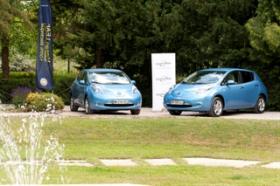Managing Director, Zero Emission Vehicles, Renault-Nissan BV
The charge towards an electric future has begun

Winning an award is always good news for a vehicle manufacturer. So does that mean that winning two important awards in the same year for the same car is twice as good? No, this year I think it's much more significant than that.
As we all know, the Nissan LEAF was voted European Car of the Year 2011 at the end of last year and this was followed, at the recent New York Motor Show, by the car being pronounced World Car of the Year.
The importance of these two awards is that they are judged by influential and experienced but above all independent motoring journalists. Their opinions count so, yes, it is great news for Nissan to be praised in this way.
But the real significance of these awards is bigger, much bigger, than a pat on the back for one particular manufacturer. By making a 100% zero emission electric vehicle car of the year, I'd suggest these awards are actually acknowledging a vision.
The clear acceptance that LEAF is, as the World Car of the Year panel said, "the gateway to a brave new electric world" sends a message to other manufacturers that the EV's time has finally come.
This vision is not Nissan's alone and it could not have borne fruit without support from our partners. The Renault-Nissan Alliance has formed partnerships with more than 90 governments, cities and other organisations around the world to promote sustainable mobility. The idea is to encourage the development of charging services, infrastructure deployment, the use of recycled materials and overall energy management systems, including second-life use of lithium-ion batteries. More such partnerships are being forged all the time.
I would also like to highlight the way Nissan itself approached the development of the car. This was not a conventional business proposal, but part of a much wider strategic vision: an investment not just in one product but in the future.
The clear acceptance that LEAF is, as the World Car of the Year panel said, "the gateway to a brave new electric world" sends a message to other manufacturers that the EV's time has finally come. Support for LEAF is as much about the dawning of a new era as it is about the car itself.
In time, as more and more EVs take to our streets, the quality of life in our city centres will improve. The air will be cleaner and noise pollution will be greatly reduced. It's not just cars that will help achieve this: great strides will be made when business operators start using electric vans for city deliveries, and replacing old diesel taxis with new electric ones will make a huge contribution to this Utopia.
LEAF's intelligent use of IT technology via Smart phone connectivity will also change and enrich lives, while LEAF has a role in contributing to energy infrastructure, too. The battery can store wind and solar power, as well as energy during off-peak hours at night. It also has the potential to be used as an external power supply.
For all the investment manufacturers are putting into EVs and battery development, considerably more is being put into continued development of gasoline and diesel engines and hybrid drivetrains to reduce emissions and improve gas mileage still further.
As it can charge to 80% capacity in just 30 minutes via the CHAdeMO quick charge system, we envisage cutting peak hour energy usage as well as promoting use of renewable power and smarter use of energy. What we are building today is sustainable mobility to realise a zero emission society.
But it is also worth keeping a sense of perspective here. By 2020, less than a decade away, we believe that while the EV will be a common sight in our cities - indeed, by then legislation might effectively have outlawed the internal combustion engine from densely populated areas - it will still only account for around 10% of global sales.
In other words, 90% of cars, vans, trucks and buses will still be powered by the ICE. So for all the investment manufacturers are putting into EVs and battery development, considerably more is being put into continued development of gasoline and diesel engines and hybrid drivetrains to reduce emissions and improve gas mileage still further.
Clearly, innovation is alive and well in the global automotive industry. Without doubt we will improve ICEs, but it is still extremely important to challenge and stretch the very extremes of this innovation, which is where zero emission lies.
print Tweet




Comments
OK. BEAUTIFUL THIS CAR`S RENAULT AND NISSAN, IS THE FUTURE, MY QUESTION: THIS CAR ARE HIBRIDOS??
BUT, VERY COST ? FOR ONE? CONGRATULATIOS.
DAGOBERTO CARRILLO
CALI, COLOMBIA S.A.
BEAUTIFUL THIS CAR´S AND THE FUTURE, IS VERY VERY GOOD
Post new comment